How Create Bootable Usb For Mac
Sep 28, 2020 • Filed to: Solve Mac Problems • Proven solutions
A Universal Serial Bus or USB drive, also known as a flash drive is a portable data storage device that includes a memory which includes a USB interface. It is typically removable and much smaller than an optical disc. Any sort of data can be stored in this device. The drives are available in various sizes and if we talk about storage, the 2TB(Tera-Byte) flash drives in terms of storage capacity are the largest ones available in the market.
Method #1: Create A Bootable Windows 10/8/7 USB on Mac with Bootcamp. As a dual-boot booting tool, Boot Camp Assistant is highly regarded in the field of creating Windows 7/8/10 bootable USB since it was released, it provides the ability to download drivers, re-partition, and add new partition on your Mac. Jun 30, 2020 Note: If you have a Mac with T2 Security Chip (that is, Macs introduced in 2018 or later), first follow this guide to allow booting from external media. After you create the bootable USB drive, the process to install it is simple. Make sure the USB drive is connected to the Mac. Next, click on the Apple logo from the top left and choose Restart. To create a bootable USB flash drive, you'll need a bootable image. Image files usually end with.ISO,.IMG, or.DMG. If you already have an image file you want to turn into a bootable USB drive, you're good to go! Otherwise, see this wikiHow to learn how to create an image from an existing CD/DVD or files on your Mac. I want to create a bootable usb for high sierra and i cant use my mac os because of hard replacement.i did exactly what this article says and everything went find and bootable flash created successfully but after trying to boot from it by holding option key i have only macintosh HD and recovery HD there and flash doesnt show up. There are lots of ways that you can create your USB Bootable for Mac OS Mojave. But in here I will show you the easy way to create your USB Bootable for Mac OS Mojave. On Windows, you simply use the Unibeast on your operating system which you installed that on VirtualBox or VMware. Be sure that it can work completely 100%.
Today, these drives are one of the most consumed used devices in the world. Thanks to their portable nature, affordability, and compatibility, USB drives are being used to send and receive endless information across a surplus of networks and platforms all around the globe. This small tool has opened the world to a stream of limitless options for storing, transferring, copying data, and much more. One of them includes Booting the Mac from such a device.
Part 1. Reasons for Mac Boot from USB:
Booting the Mac from USB in a way gives the power back to the user. The likeliest of the reason for choosing the boot from the USB method is that your Mac won't start which denies the user access to the computer. Using an external source like the USB drive helps the user get around the problem. It provides the user access to the contents of the internal drive, assuming the data is safe and not corrupted. It also helps to repair the Mac disk with Disk Utility and other tools. Here are the top reasons why the user should choose to Boot Mac from USB:
- Allows the user to install a different version of macOS.
- It allows the user to test a new version before you decide to upgrade.
- Allows risk-free testing of the Beta version.
- Faster and efficient.
- By installing older versions through USB, it permits certain Apps to run which are not compatible with the latest macOS.
Part 2. Preparations for Booting Mac from USB:
To ensure a risk-free procedure certain measure should be taken:

- The user should buy a name-brand flash drive.
- The USB should contain 16-32GB of free space.
- The user should scan the flash drive with some reputable Anti-Virus software.
- The user should check to see what size of ports they have on the Mac. A 12' Mac only contains a single C-Type port.
- Make sure to purchase the C port flash drive to avoid any inconvenience.
- It is recommended that the user should go with a USB 3.0 supported drive, with a size of 16GB to ensure a swift transfer of data.
- The USB drive should be formatted with a supported GUID partition.
- It should contain an OS X installer or a usable operating system to work with.
How To Create A Bootable Usb For Mac Os
Part 3. How to Create Bootable USB on Mac:
There are a few general guidelines that can help get your machine started which are mentioned above, regardless of the OS the user prefers.
Here are the methods to create a bootable USB drive on Mac.

- Creating a Bootable USB Using Terminal.
- Create a Bootable drive with the help a third party compression software, which is available for free.
Creating a Bootable USB Using Terminal:
The terminal is the default gateway to the command line on a Mac. It is just like the Command Prompt feature works for MS Windows. The Terminal feature ensures a hassle-free experience for the Mac user without the conventional pointing and clicking, the user just has to type the commands and the computer does the rest. The user can find Terminal in the Applications>Utilities folder or it can be checked in the finder utility.
Using the Terminal feature is the most simple way to create the bootable USB drive. The user just needs to follow one easy step which is renaming the MyVolume portion of the command with the name of the drive. The name of the drive can be changed using the Disk Utility of Mac.
Here are the steps required after opening the Terminal feature to create a bootable USB drive.

- Copy and paste the command which is suited for the version of the operating system into the Terminal window.
- The command for macOS Mojave is as follows:
How Create Bootable Usb For Mac Os High Sierra
sudo /Applications/InstallmacOSMojave.app/Contents/Resources/createinstallmedia --volume/Volumes/MyVolume
- Press the Return key.
- Enter the password.
- Confirm to erase the USB drive by typing Y followed by the Return key.
- The terminal will erase all the data inside the drive and create the bootable USB drive.
If there is a need to install a different version of the operating system then the user just has to replace the above-underlined command with their desired version of OS. For example, if the user wants to install Mac OS Sierra instead of Mojave then they would have to replace 'Mojave.app' with 'Sierra.app' inside the command line.
Part 4. How to Boot Mac from USB Media:
After creating a bootable USB drive, the user simply needs to plug the created drive into the open port on the Mac. Here are the steps to boot Mac from the USB flash drive:


- Power on the system.
- Press and hold the Option (Alt) key on the keyboard when the computer starts.
- Select the USB drive as a startup disk when the option appears.
- The system will start the boot process off the USB drive.
- Install the operating system from the macOS utilities.
- Data can be restored by using the Time-Machine backup option.
Part 5. How to Recover Data from Unbootable Mac:
The Mac becomes unbootable when the BIOS which is a firmware that is used to perform hardware initialization during the booting process fails to recognize the startup process. It usually happens when there is a failed system update, system crash, damaged MBR, or when the drive becomes corrupt.
Recoverit Mac Data Recovery tool is the most efficient option to recover all the lost data when Mac becomes unbootable. Developed by Wondershare, Recoverit is one of the most preferred recovery tools in the world. The tool provides an instant preview of what is recovered after a detailed scan. It allows you to connect almost every type of portable device and recover data from them. Data can be restored by performing the recovery and repair process. The process involves the installation of the Recoverit software that offers users the chance to get back the important data that they had lost.
First of all, the user is required to download the Recoverit software on the Mac system from the official website. Here are the following step required to recover data from an unbootable computer:
Reinstall Mac Os From Usb
- Installation: Please Install Recoverit by clicking on the icon.
- Select the folder: Select the 'Recover from Crash Computer' option.
- Initiate Recovery Process: Click on 'Start' for the recovery process to launch.
- Create Bootable Drive: Select the 'Create USB bootable drive' option and click on 'Create'.
- A pop up will appear that will prompt the user to format the USB drive.
- Format the Drive: Click on 'Format' Now.
- The process will start that will create a bootable flash drive.
- Recover Data: After the boot is completed, click on the 'View Guide' option to recover data.
- Start Recoverit: Launch the Recoverit software again.
- Recover Data: Scan the drives for lost data.
All hope gets lost when the computer becomes unbootable and the data gets deleted. Recoverit recovery software is the most convenient program when it comes to retrieving lost data from the computer.
Conclusion:
How To Create Bootable Usb For Mac
Installing the macOS from a USB flash drive gives the user an instant solution when the Mac installer due to some reason refused to work. The method to create a bootable drive is easier than it sounds. Now, you know what to do whenever you want to upgrade your macOS from a bootable external source by following different methods to ensure a safe and hassle-free process. If you lose valuable data when the Mac becomes unbootable then you can easily recover the lost files by using the Recoverit recovery software. Recoverit guarantees data recovery in no time.
Video Tutorial on How to Boot Mac into Recovery Mode
How Create Bootable Usb On Mac
What's Wrong with Mac
- Recover Your Mac
- Fix Your Mac
- Delete Your Mac
- Learn Mac Hacks
